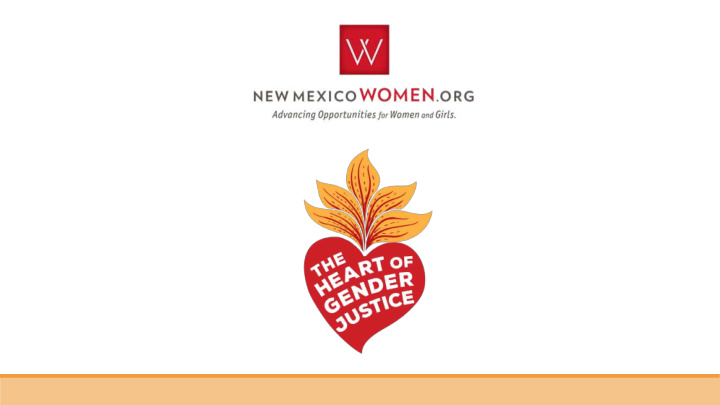



NewMexicoWomen.Org Works to Advance Opportunities For Women And Girls Statewide So That They Can Lead Self-Sufficient, Healthy And Empowered Lives EDUCATE: Through research, communications, and trainings, NMW.O brings public attention to the issues affecting women and girls with an eye toward influencing philanthropy and policy. LEAD: NMW.O Listens to community and facilitates alliances among non-profits, funders and other sectors in order to concentrate resources and foster collaboration. INVEST: NMW.O leverages philanthropic investments in programs serving women and girls statewide through our donor education and strategic grant making efforts.
2017 RESEARCH REPORT: The Heart of Gender Justice in New Mexico: Intersectionality, Economic Security, and Health Equity A joint research project of NewMexicoWomen.Org and a multi-disciplinary research team of social policy scholars of color from University of New Mexico College of Population Health and RWJF Center for Health Policy. Focusing on women in New Mexico, this report includes qualitative findings from statewide community dialogues around gender, health, and economic equity, as well as quantitative findings from an analysis on the link between economic security and women’s health status by race and ethnicity.
Purpose and Aims of Community Engagement and Research 1. Identify the catalytic intersections between health equity and economic security in New Mexico; 2. Learn about the lived experiences of communities in relation to this intersection and recognize community members as experts; 3. Clarify and prioritize the particular needs of communities in this field; and 4. Determine what role NMW.O will play in addressing those needs and supporting the work of communities.
Approach - Intersectionality • Analytic tool, Kimberlé Crenshaw, 1989 • Understanding how systems of oppression intersect • Articulating multiple aspects of identity and experience that enrich health, economic opportunities, and lives, as well as challenge, and complicate them. • Acknowledging how gender intersects with other social factors such as race, class, ability, sexuality, religion, age, and environment to impact one’s lived experiences.
How does our work relate to CCJ Interim Committee? Recent data and news articles: “Fifty percent of the occupancy at our jail right now, at the Doña Ana County Detention Center, are “…data shows the population of women in prison in people that are waiting for mental health pretrial the state had increased by 47 percent since the competency—mental health support and start of 2001” –The SF New Mexican assessments. Women typically have a 30 percent higher rate of being jailed with mental health “40 percent of female inmates in New Mexico are conditions than male counterparts. We need to incarcerated for drug offenses” –The SF New figure out a way to provide mental health services Mexican asap.” “We have spent the last three or four years -Las Cruces research participant scratching our heads trying to figure out what is going on with the female population.” –New Mexico Sentencing Commission
How does our work relate to CCJ Interim Committee? “Participants across the state described a context of structural underinvestment (and in some cases divestment) in mental health and substance abuse recovery services, with decreasing resources available, especially in rural communities.” “Rural communities described a lack of consistent services and safety nets. The result is very little trust in services, as one day they are open and available, and the next they are defunded and closed.”
Systems Approach to Policymaking • Consider the conditions (including the health system) in which people are born, live, work, play, pray, and age, also known as the social determinants of health . • Understand how health conditions are shaped by social structures which impact distributions of power and drive allocations of resources . • Focus on root causes to poverty, violence, and incarceration. • Multi-sector approaches to systems change and resource allocations.
Recommendations for Policymakers and Public Sector • Identify communities most impacted: Low-income and rural communities of color tend to be impacted the most. • Acknowledge the effects of historic trauma and support healing efforts: Communities want longer-term, culturally rooted healing as a critical need to tackle root causes to the issues we face in our state. • Apply a social justice lens to funding and policymaking: Communities described the need to educate funders and policymakers. • Utilize and partner with the nonprofit and philanthropic sector: This sector fills the gaps where the public sector cannot.
Thank you! Questions?
Recommend
More recommend